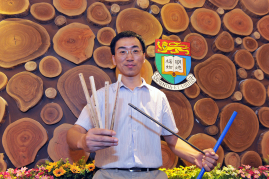Media
HKU geographer led tree-ring study finds El Niño amplitude increases with global warming More extreme weather conditions ahead warned
27 Aug 2013
An international research team, led by Dr. Jinbao Li of Department of Geography, The University of Hong Kong Faculty of Social Sciences, finds that recent El Niño behavior is at the highest activity for the past 700 years, possibly a response to ongoing global warming. If this trend of El Niño activity continues, we will very likely see more extreme weather events such as floods and droughts to occur around the globe. This research is now published online in a prestigious international journal Nature Climate Change. For the paper, please visit http://dx.doi.org/10.1038/nclimate1936.
Research methodology and key research findings
El Niño and La Niña, the anomalous warming and cooling of sea surface temperatures (SSTs) in the tropical Pacific every two to seven years, bring about weather extremes worldwide.
Predicting how El Niño will change with global warming is of enormous importance to society. Instrumental records are available for only about the past 150 years, too short to discern whether El Niño has changed under global warming.
Dr. Li and colleagues found that ancient trees have recorded past El Niño variability in their annual growth rings. For example, the unusually warm sea surface temperatures in the eastern Pacific during El Niño lead to unusually wet winter and thus wider tree rings in southwest North America, whereas drought and narrower tree rings during La Niña.
By analyzing more than 2200 tree-ring records from Asia, New Zealand, North and South America, Dr. Li and colleagues developed a 700-year El Niño record of unprecedented accuracy, as attested by high correlations with instrumental records and tropical corals. With this record, the team found that El Niño activity was generally low during the fourteenth to nineteenth centuries, but became unusually high after the 1880s. A statistical test further shows that recent El Niño activity is well beyond the range of random variability, suggesting that the enhancement is likely due to changes in the Pacific mean state associated with global warming.
These findings provide crucial guidance for improving climate models. Current climate models disagree on the El Niño response to global warming, with some showing an increase, some no change, and some even a decrease in El Niño variability. Results from this new study suggest that models with a damped response may underestimate the sensitivity of El Niño to increasing anthropogenic radiative forcing.
In addition, the team also found a robust response of El Niño to large tropical volcanic eruptions. Anomalous cooling (i.e., La Niña) tends to occur in the eastern Pacific in the year of eruption, followed by anomalous warming (i.e., El Niño) one year after. This suggests large tropical volcanic eruption could cause worldwide extreme weather through its effects on El Niño.
Research implications for China
El Niño has dramatic influence on weather and climate in mainland China and Hong Kong. During El Niño, warm winter tends to occur in mainland China, summer rainfall tends to increase in the Yangtze River basin, while the number of tropical cyclones affecting China, including Hong Kong tends to decrease. This study suggests that with enhanced El Niño variability under global warming, mainland China and Hong Kong will both see more extreme weather events such as floods and droughts, with great implications for city infrastructure and long-term water resources management.
About the research team
The research is led by Dr. Jinbao Li, Assistant Professor of Department of Geography, HKU Faculty of Social Sciences, and Roger Revelle Professor Shang-Ping Xie, Scripps Institution of Oceanography, University of California at San Diego. Other key members include Dr. Edward R. Cook, Ewing Lamont Research Professor at Lamont-Doherty Earth Observatory, Columbia University, Dr. Mariano S. Morales at Instituto Argentino de Nivología, Glaciología y Ciencias Ambientales (IANIGLA), Argentina, Dr. Duncan A. Christie at Facultad de Ciencias Forestales y Recursos Naturales, Universidad Austral de Chile, Chile, and Dr. Nathaniel C. Johnson at International Pacific Research Center, University of Hawaii at Manoa, USA.
For media enquiries, please contact Communications and Public Affairs Office:
Assistant Director (Media) Ms Trinni Choy, tel: 2859 2606 email: pychoy@hku.hk, or
Manager (Media) Ms Rhea Leung, tel: 2857 8555 / 9022 7446 email: rhea.leung@hku.hk
An international research team, led by Dr. Jinbao Li of Department of Geography, HKU, develops a 700-year El Niño record of unprecedented accuracy by analysing more than 2200 tree-ring records in the Pacific Rim.
Ancient trees, such as Polylepis tarapacana in the South American Altiplano (above), grow in rocky soils and are sensitive to climate anomalies associated with large-scale climate patterns given by the El Niño. Reading the rings of this and thousands of other trees on the Pacific Rim, this new research finds that recent El Niño behavior is at the highest activity for the past 700 years, possibly a response to ongoing global warming (Image credit: Duncan Christie).



